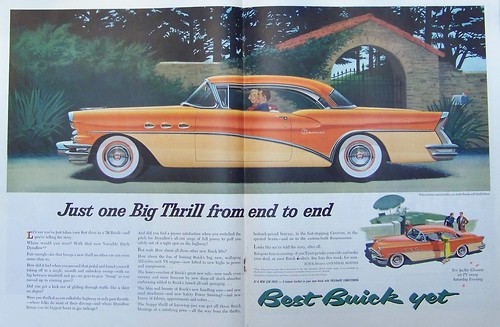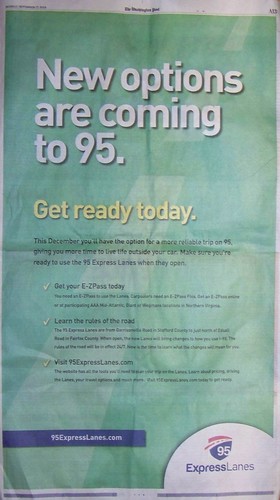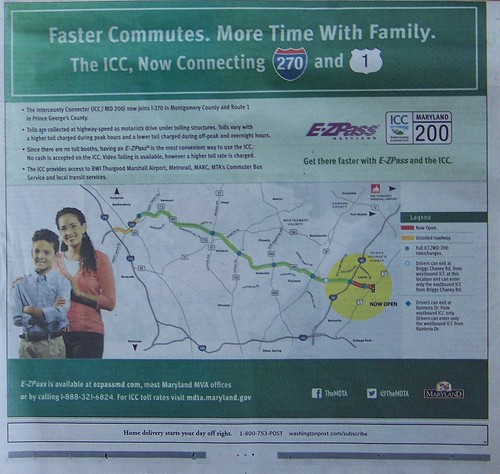Cars vs. Transit: Cars are winning
Over the weekend I picked up a bunch of Saturday Evening Post and Life magazine issues from the 1940s, 1950s, and 1960s. I eagerly buy such ephemera when I come across it for a couple reasons.
Many of the stories (on the decline of cities, road building, land use, crime, etc.) are interesting windows into the development of the mass economy, national attitudes, etc., Plus, the 1940s and 1950s were the golden years of illustrated ads (as opposed to photo-based ads) and image advertising by corporations and industry associations. The ads provide great insights into foundations of transportation, land use, and urban planning practices that we deal with today.
1. One of the things that I have been thinking about lately, not just in response to the recent report, Subsidizing Congestion: The Multibillion-Dollar Tax Subsidy That’s Making Your Commute Worse, by the TransitCenter and Frontier Group, which makes the point that the US provides more tax benefits for car use than transit use, is an article from Businessweek ("The Petro States of America,) making the point that the US is a major oil producer and that needs to be considered when trying to understand general government and economic policymaking in the United States. It's so true.

Anti Keystone pipeline demonstration outside of the DC house of Louisiana Senator Mary Landrieu, 11/17/2014.
(Note that the report also makes the point that transit benefits disproportionately help the better off. The transportation demand management benefits of transit especially to central business districts in cities like DC or Manhattan, which couldn't function if there wasn't a transit alternative to cars, justify policy promoting transit.
That being said, I believe in special transit discounts for lower income households, along the lines of what the San Francisco MUNI system does, and general subsidy of transit allowing for low fares and comparatively lower monthly pass rates, e.g., DC's monthly subway pass costs double that of the NYC Subway system.)
2. As the first section of streetcar line is getting ready to open to the public, yesterday the Washington Post editorialized ("Trolley troubles") that the Washington DC streetcar program should be put on hiatus, and re-assessed. From the article:
While for a variety of reasons I agree that the program has been poorly planned and has taken way longer than necessary to start operating, and maybe it isn't the best transit mode to be investing into to get the best return on investment, I can't help but wonder if the editorial board isn't captured by automobile-centric thinking--certainly all the poorly argued pro-automobility letters hat get published make you wonder--and is doing a bait and switch, arguing for "analysis" but really more concerned about promoting automobility.
... which is what all the other opponents are doing too! ("streetcars are old technology; streetcars are less flexible than buses because they are on tracks, sure lots of people willingly ride buses" etc.)
For one thing, the arguments against streetcar system planning are somewhat overstated because DC has always planned for incremental additions to the system, and forward movement has been hampered by many missteps along the way (contrast this to Seattle. Of course those plans will be assessed anyway as the streetcar finally opens to riders..
On the other hand, over time, as the system is expanded and more people use it, the various complaints about streetcar service will likely fade away.
(And even if streetcars aren't widely used in the US, they are in Europe and Australia, and those experiences are relevant to planning here.)
3. But the DC streetcar program has been buffeted by opposition, from seeming progressives, especially from the "older people" who tend to populate the membership of legacy community improvement organizations in the city such as the Capitol Hill Restoration Society and the Committee of 100 on the Federal City, which have expressed opposition. (C100 is particularly proud of their report on the topic, which I didn't think was particularly impressive.)
Although they couch their opposition as something that has to do with the planning, and how the system uses "old technology" (actually the technology is as modern as any technology behind automobiles) and that buses are better and more mobile, even though those criticizing the system, like the Post editorial writers, mostly don't use transit at all, mostly driving.

Buick ad, Saturday Evening Post, 7/7/1956
This is a real problem, especially because most of Washington, DC's elected officials--10 of the incoming 13 representatives--represent and/or live in "the outer city" where automobile use is more prevalent, residents are older, and residents are more organized and active in promoting their car-centric views (see "DC as a suburban agenda dominated city").
4. This has come to a head in Arlington County, until today a national best practice example in linking transit and land use planning, where the Arlington County Board voted to abandon its commitment to streetcar development on Columbia Pike and in Potomac Yard/Crystal City ("Arlington officials halt efforts on streetcars for Columbia Pike, Crystal City," Washington Post).
This occurred in the face of vociferous opposition (very similar to opposition in DC) in some quarters, as represented by the election to two members to the Board who ran on an anti-streetcar platform--the resignation from the Board by Chris Zimmerman, who was the region's most prominent pro-transit elected official, set up the opportunity for a replacement by an anti-transit politico, arguing in favor of "financial prudence."
5. Meanwhile, the incoming Maryland Governor, Larry Hogan, ran on an anti-spending platform which included defunding light rail programs in the Washington suburbs and Baltimore, which worries the proponents of the Purple Line in the DC suburbs and the Red Line in Baltimore City and County.
6. But highway expansion continues apace. High Occupancy Toll Lanes ("Lexus Lanes") in Virginia and north of Baltimore open next month.on I-95 and the full length of the tolled Inter County Connector in Maryland is now open too, as evidenced by ads running in the Washington Post.


Labels: car culture and automobility, government oversight, protest and advocacy, transportation planning



7 Comments:
There is a lot to unpack in the Arlington streetcar decision.
I'm not above saying this cancellation may be a stunt, although Fissette is a pretty sane guy and doesn't do moves like that.
I'll note that he used the term place-making, which should please you. In fact I'd say a key problem is they didn't see the placemaking.
Zimmerman's role is also key, not in a good way. His contract and subsequent employment by AECOM probably left a bad taste with fellow board members.
In both Arlington and DC's case, the placement of the line seems like a bad decision.
A line from the pentagon to skyline makes sense in the 1960s or 1970s. Not today, and doubly so when the quarter-pentagon has been built on 395.
Bailey's crossroads could use some investment and densification. Could bailey's have been the next Ballston? Maybe.
But essentially recycling a 1960s plan into an urban streetcar wasn't going to work.
As you have pointed out, WMATA essentialy gave up around 2001 or so. I do think a metro line to Bailey's could work, as it ties into a larger job network. a 40+ minute ride on the streetcar into the pentagon city, then a metro ride elsewhere? Not very viable.
Pentagon to Skyline was one of concepts for a Metro line back in the day.
That's why you have dense "Southern Towers," not unlike how a small office building district developed in the area that became the PG Plaza Metro station. The property owners knew that a subway would be built eventually. Like Skyline, they started early, but only one came through.
I think you make a very good point (also relevant to streetcars in DC which I intend to write about separately) that in thinking about transit expansion in Arlington, the county has to be very judicious in considering ROI and maximum benefit, given that resources are limited.
From that standpoint, your point about Baileys Crossroads is pretty important.
2. wrt the streetcars in DC the reason I was favorable was in the belief that rail would result in a 20% to 40% ridership increase vs. bus.
but now, I don't know how reasonable an assumption that is.
As importantly, in order to accomplish that you need way more streetcars than the city has agreed to purchase.
E.g. on H Street, there are 280 runs/day for 23 hours. (I am relying on memory...)
During peak, a run takes 45 minutes and the headway is 7 minutes, so you need at least 8 buses, and probably a couple more.
So that would mean at least 10 streetcar sets to run at that headway. And if you expect more ridership, you'd want double cars, not just the single units they have.
Plus, the issue is with limited resources, you can't really satisfice, you have to make the hard decisions, the best decisions, focused on ROI.
In DC, I'd say the separated blue line but with the originally proposed but still tweaked alignment, rather than the truncated alignment of the Momentum plan (the difference is that there would still be service east of Union Station in the original plan, which is not in the new concept) is more valuable.
Then also, the issue is streetcars vs. light rail and dedicated alignments, underground maybe like Seattle, on maybe a couple streets, like 16th St. for one.
But the political shaping of the planning moved us away from making the best choices, and now everything is fouled up.
RE: ROI. given Arlington abysmal CRE vacacy rate -- over 30% in Rosslyn -- adding more office space is the last thing that they need.
There is still demand for housing, but those building need someplace to work. And it wasn't going to be along Columbia Pike.
if we distinguish between streetcars and light rail, then the modern incorporation of streetcars into the mobility network is on small runs, intra-district kind of transit.
The tourist lines are exceptions, like SF, which are lines, which also service residents. (And the new line serving Soma, which I don't know much about.)
The "streetcar" in Arlington and Fairfax wasn't that kind of line, and as you said, it would take a long time to get to Pentagon, and then you'd still have to ride to get somewhere else.
2. I think streetcars make sense for the intra-district and repositioning a district within the context of the metropolitan landscape, as I have written about before.
But for long routes, streetcars don't make sense, at least, not if you want faster service, and not if the line isn't also serving major destinations.
The trams in Melbourne are a mix of "streetcar" and light rail service. Lots of the lines have exclusive street right of way, but there is mixing. They have 500,000 daily riders on all the lines.
Toronto's are a mix of the equivalent of bus lines and streetcar-light rail, and they run in traffic. They have almost 300,000 daily riders.
3. not dissimilarly, BRT in the US is completely different from BRT in South America, even though the SA concept is used to justify the provision of BRT in the US. Basically US BRT is rapider transit on single lines.
well I always struggle with your "intra-district" but I analogize it what Circulator could be.
Altought traffic is an issue. It took me 45 minutes a few weeks ago to get from Washington Circle to City center on rush hour circulator. I didn't have my metro card and wanted to save some money. Bad idea.
excellent posting Richard- my compliments. As for DC's streetcars- I still want to express the concept of reusing historic streetcar rights of way instead of reinventing the wheel- we already have wonderful rights of way underutilized- Pennsylvania Avenue, and R street out to Glen Echo. The DC planners ignored these wonderful options and it is a big mistake. I also think the streetcars will become acceptable once they have been seen and people are used to them- as you have rightly pointed out. Arlington is making a big mistake and Maryland looks to entrenching against the Purple Line which is sad. Again- these issues have a lot less to do with political parties than generations splitting/fracturing and "heritage" groups that just do not get it.
wrt that bus trip, I've made plenty of similar mistakes in the past. It's why whenever I can, I prefer to bike. It's faster, and I have more control over time and conditions.
Waiting forever for buses (G2, H8), getting held on buses because of presidential motorcades and stuff...
Post a Comment
<< Home